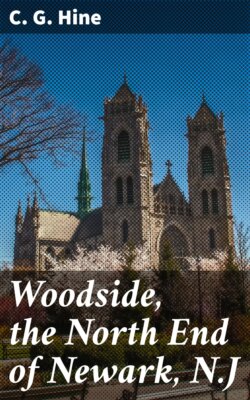Читать книгу Woodside, the North End of Newark, N.J - C. G. Hine - Страница 8
На сайте Литреса книга снята с продажи.
WOODSIDE SUBMERGED.
ОглавлениеBut, alas! on the fifth of April, 1871, our independence was lost forever and most of us were turned over to the tender mercies of the Newark politicians, who have ever since exercised a wonderful ingenuity in taxing us poor inhabitants to the limit and giving as little in return as possible. In fact the only thing we get for our taxes, aside from the fire department service, is an occasional policeman, who comes twice each year with tickets to sell for ball or excursion. Does the road need paving or sewering, the cost is assessed on the abutting property, and so is it with sidewalks, and even with the shade trees which the city fathers insist are good for us, and having planted them they send us a bill therefor. The Woodsider has never yet been able to ascertain what he is taxed for, unless it is to keep the politicians in good running order. This remark should be qualified to some extent so far as the police are concerned, for no locality could have a better protector than Mounted Officer Niblo, who has long been on this post and who, we hope, will long remain; there is also a patrolman who does his duty as though his job depended on it, but the majority of them seem to have the true politician’s idea as to what is good for them.
The sin was legalized by “An Act to divide the township of Woodside between the City of Newark and the township of Belleville”.
The boundary of Woodside is given as “beginning at the intersection of the centre of the Second river with the centre of the Passaic river; thence (1) running southerly along the centre of the Passaic river, the several courses thereof, to the northerly line of the city of Newark (just below Gully road); thence (2) westerly along the said line of the city of Newark to the centre of the Great Boiling spring, at the line of the township of Bloomfield; thence (3) northerly along said line to the centre of Branch brook; thence (4) northeasterly along the centre of said brook, the several courses thereof, to the centre of Second river; thence (5) down along the centre of Second river, the several courses thereof, to the centre of Passaic River, and the place of beginning.”
All of the township of Woodside not included within the above mentioned boundaries was annexed to the township of Belleville.
James S. Gamble, Horace H. Nichols and Charles Akers, of the township of Woodside, were among the commissioners appointed to see that the division was properly carried out.
The act was approved April 5, 1871.
The transition from independence to slavery was engineered, I am told, by three men for personal and selfish motives, and it gives me great pleasure to record that all three were sadly left. One longed to be sheriff, but must live in Newark to secure the nomination, and did not wish to remove from this pleasant land; the two others were holders of considerable property, and it was their hope that a boom in building lots would set in that would materially fatten their pocketbooks, and so in some dark and mysterious way our model township was ceded to Newark.
But the politician failed of election and the lots did not sell, and “one of the disappointed real estate owners, like Judas Iscariot, went out and hanged himself”.
Once the place belonged to Newark the street car company could, of course, do what it liked with the roadway, and it shortly proceeded to regrade (I had almost said degrade) Washington avenue above Elwood, utterly destroying the carefully laid out parkway on which property owners had spent much thought and money. Terraces and trees were ruthlessly cut down and, to provide a dumping place for the earth removed, Oraton street was cut through and filled in with the Washington avenue debris. “Ichabod was written upon the avenue and the fine name of Oraton could in no way lend dignity to the new street”, which at that time was largely given over to negroes and laborers.
